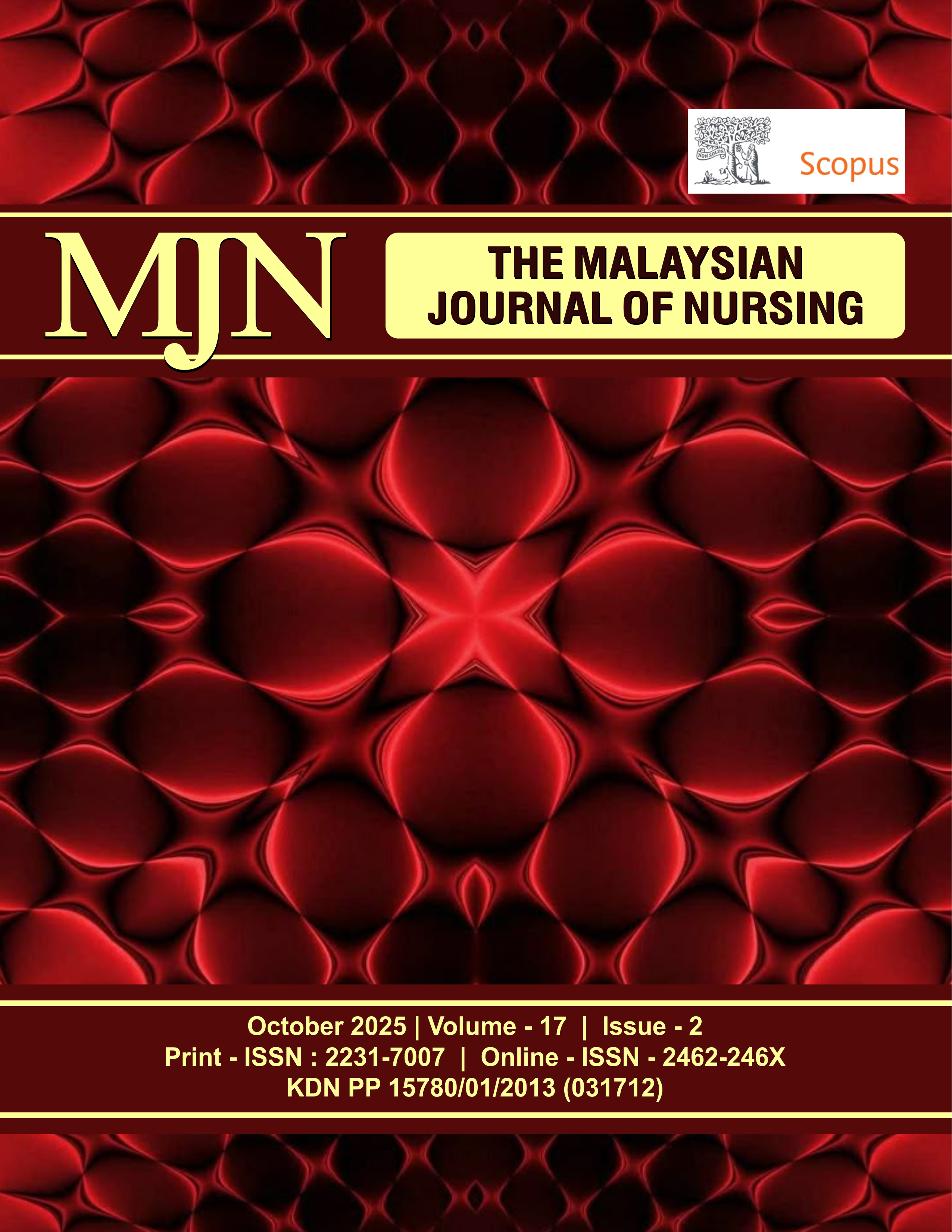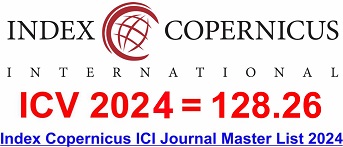Exploring Knowledge and Practice of Critical Care Unit Nurses with a View to Develop and Evaluate the Effectiveness of Hemodynamic Monitoring Guidelines
DOI:
https://doi.org/10.31674/mjn.2025.v17i02.023Abstract
Background: Critically ill patients often suffer from a complex cardiopulmonary instability. This instability requires an integrated approach of continuous monitoring. Nurses working in critical care units often found themselves having limited knowledge and practices, which led to inappropriate interventions. Objective: To assess knowledge and practice of CCU nurses on monitoring selected haemodynamic parameters. To develop and evaluate the effectiveness of selected haemodynamic monitoring guidelines in terms of improvement of knowledge and practice. Methods: The 1st phase was an exploratory study among 300, and the 2nd phase was a quasi-experimental study among 60 nurses. Data was collected using the convenience sampling technique with a self-reported knowledge questionnaire and practice observation checklist. Results: Most of the first-phase nurses (57.67%) were in the age group of 25-28 years, and 212 (70.67%) were diploma nurses (GNM). As per level of knowledge, 11 (3.67%) and 146 (49%) had poor and average knowledge, whereas only 65 (21.67%) and 78 (26%) had good and very good knowledge. Regarding practice, the majority, 181 (60.33%), had an average practice score, while only 107 (35.67%) demonstrated good practice. The statistical data revealed a significant positive association between the level of knowledge and the stream of nursing education (χ²=16.21), professional qualification (χ²=17.19), and critical care specialisation (χ²=77.47). In the 2nd phase, a paired t-test highlighted that the pre-test & post-test mean knowledge score difference was 18.93, SD 5.24, with a significant t-value of 27.99, and the pre-test and post-test mean practice score difference was 26.95, SD 7.88, with a significant t-value of 26.50, at P<0.05. Conclusion: Hence, haemodynamic monitoring guidelines were able to improve CCU nurses’ knowledge and practices.
Keywords:
Critical Care Unit, Guidelines, Hemodynamic MonitoringDownloads
References
Amarilla, V. G. V., Miamoto, I. M., Dyba, D., Junior, J. M. S., & Gomes, B. C. (2025). Importance of basic hemodynamic monitoring: A narrative review. Perioperative Anesthesia Reports, 3, 0-0. http://dx.doi.org/10.61724/par.e00022025
Avcı, Y.Ş., & Yılmaz, D. (2024). The effect of different bed head angles on the hemodynamic parameters of intensive care patients lying in the supine position: A quasi‐experimental study. Japan Journal of Nursing Science, 21(3), e12589. https://doi.org/10.1111/jjns.12589
Baldetti, L., Cosenza, M., Galdieri, C., Gallone, G., Ricchetti, G., Gaspardone, C., ... & Scandroglio, A. M. (2025). Invasive Hemodynamic Monitoring in Acute Heart Failure and Cardiogenic Shock. Reviews in Cardiovascular Medicine, 26(6), 27034. https://doi.org/10.31083/RCM27034
Brezić, J., Kurtović, B., & Friganović, A. (2021). Levels of Knowledge in Nursing Students on Hemodynamic Monitoring–A Cross-Sectional Study. Croatian Nursing Journal, 5(1), 29-39. https://doi.org/10.24141/2/5/1/3
Giusti, A. C. B. de S., Cornélio, M. E., de Oliveira, E. M., Giguère, J.-F., & Gallani, M. C. B. J. (2024). Standard practices in cardiac monitoring: training needs of intensive care unit nurses. BMC Nursing, 23(1), 82. https://doi.org/10.1186/s12912-024-01742-1
Diamond, M., Peniston, H. L., Sanghavi, D. K., & Mahapatra, S. (2024). Acute respiratory distress syndrome. In StatPearls [internet]. StatPearls Publishing. https://www.statpearls.com/articlelibrary/viewarticle/17172
Farah, H. A, & Khleif, M. (2024). Knowledge, attitude, and practice of Palestinian critical care nurses about hemodynamic instability in patients with cardiovascular diseases. BMC Nursing, 23(1), 1-8. https://doi.org/10.1186/s12912-024-02549-w
Fokeladeh, H. S., Montayre, J., & Stewart, D. (2024). International Council of Nurses 2025 Congress: Nursing power to change the world. International Nursing Review, 71(4), 681-683. https://doi.org/10.1111/inr.13077
Gazerani, A., Pourghaznein, T., Gholoobi, A., Miri, K., Namazinia, M., & Mazloum, S. R. (2024). Enhancing hemodynamic stability: the role of liaison nurses in patient transfers to angiography. BMC Nursing, 23(1), 668. https://doi.org/10.1186/s12912-024-02337-6
Howthan, A. M. (2024). Nursing role for intra-abdominal pressure (IAP) monitoring in critical care of adult patients: A scoping review. Journal of Intensive and Critical Care, 10(5). https://doi.org/10.35248/2471-8505-10.05.41
Hashmi, M. (2024). Knowledge competency score among critical care nurses concerning intra-abdominal hypertension measurement. Journal of Nurses and Midwives Pakistan, 4(1), 1-7. https://kgpublisher.com/index.php/pjnm/article/view/92
Huang, J. J., Yu, C. C., & Lo, H. Y. (2024). 運用多元策略提升血液動力學監測儀照護正確率 [Using multiple strategies to improve the accuracy of hemodynamic monitoring care]. Nursing Magazine, 71(1), 72-80. https://doi.org/10.6224/JN.202402_71(1).09
Jafari, A., Pouladi, S., Bagherzadeh, R. & Vahedparast, H. (2025). Is the care performance of critical care unit nurses in angina management consistent with evidence-based guidelines? An observational study. Frontiers of Nursing, 12(2), 2025. 245-253. https://doi.org/10.2478/fon-2025-0026
Jeshvaghani, T. A., Mofrad, M. N., Farahani, Z. B., & Nasiri, M. (2021). Nurses' educational needs assessment for hemodynamic monitoring in intensive care units. Journal of Continuing Education in the Health Professions, 41(3), 169-175. https://doi.org/10.1097/CEH.0000000000000344
Kang, H. (2021). Sample size determination and power analysis using the G* Power software. Journal of Educational Evaluation for Health Professions, 18. https://doi.org/10.3352/jeehp.2021.18.17
Kulkarni, A. P., Govil, D., Samavedam, S., Srinivasan, S., Ramasubban, S., Venkataraman, R., ... & Myatra, S. N. (2022). ISCCM guidelines for hemodynamic monitoring in the critically ill. Indian Journal of Critical Care Medicine: Peer-reviewed, Official Publication of Indian Society of Critical Care Medicine, 26(Suppl 2), S66. https://doi.org/10.5005/jp-journals-10071-24301
Li, Z., Lu, F., Dai, Y., Sheng, M., Su, L., Yao, P., & Wang, H. (2024). Knowledge, attitudes, and practices (KAP) regarding intra-abdominal pressure monitoring among pediatric intensive care nurses: A cross-sectional study. International Journal of Nursing Sciences, 11(3), 381-386. https://doi.org/10.1016/j.ijnss.2024.05.002
Lommi, M., Diaz, M. Y. T., Piredda, M., Raffaele, B., Ricci, S., Montini, G., ... & Porcelli, B. (2025). Nurses' Knowledge and Self‐Efficacy in the Management of Vascular Access Devices Before and After Field Training Course: A Quasi‐Experimental Study. Nursing Open, 12(4), e70090. https://doi.org/10.1002/nop2.70090
Makwana, D., Engineer, P., Dabhi, A., & Chudasama, H. (2023). Sampling methods in research: A review. International Journal of Trend in Scientific Research and Development, 7(3), 762-768. https://www.ijtsrd.com/papers/ijtsrd57470.pdf
Mostafa, A. M., Allam, Z. A., Ibrahim, A. G. E., & Diab, S. M. (2025). Nurses' Knowledge and Practices Regarding Devices Associated Infection at Intensive Care Units. Tanta Scientific Nursing Journal, 36(11). https://doi.org/10.21608/tsnj.2025.418169
McEvoy, N. L., Credland, N., Cribbin, D., Curley, G. F., & Humphries, N. (2025). Critical Care Nursing Workforce Retention from an Irish Perspective: A National Survey. Nursing in Critical Care, 30(4), e70094. https://doi.org/10.1111/nicc.70094
Mohamed, A. E. S, Taha, A. S., & Mohamed, R.F. (2023). Effect of educational guidelines on nurses’ performance regarding caring of patients with an intra-aortic balloon pump. Journal of Nursing Science Benha University, 4(2), 912-925. https://doi.org/10.21608/jnsbu.2023.310633
Mori, C. (2024). Exploring, Investigating, and Uncovering: What Is Research? Orthopaedic Nursing, 43(4), 242-245. https://doi.org/10.1097/NOR.0000000000001045
Norte, R. J., Adegbola, M., Alejandro-White, J., Bashir, M., Bashmakov, A., Berney, A., ... & Wilson, J. (2024). The 2025 International Neuroscience Nursing Research Symposium Abstracts. Journal of Neuroscience Nursing, 10-1097. https://doi.org/10.1097/jnn.0000000000000816
Pinsky, M. R., Cecconi, M., Chew, M. S., De Backer, D., Douglas, I., Edwards, M., ... & Vincent, J. L. (2022). Effective hemodynamic monitoring. Critical Care, 26(1), 294. https://doi.org/10.1186/s13054-022-04173-z
Rali, A. S., Butcher, A., Tedford, R. J., Sinha, S. S., Mekki, P., Van Spall, H. G., & Sauer, A. J. (2022). Contemporary review of hemodynamic monitoring in the critical care setting. US Cardiology Review, 16, e12. https://doi.org/10.15420/usc.2021.34
Teesdale, R. M. (2025). Role of Nursing in Initiation and Maintenance of a Neonatal Hemodynamics Program. Neo Reviews, 26(7), e446-e450. https://doi.org/10.1542/neo.26-7-031
Thomas, D., & Zubkov, P. (2023). Quantitative research designs. Quantitative Research for Practical Theology, 103-114. https://www.studocu.com/ph/document/arellano-university/practical-research/quantitative-research-designs-chapter-for-practical-theology-cit-2023/123522996
Vincent, J. L., Joosten, A., & Saugel, B. (2021). Hemodynamic monitoring and support. Critical Care Medicine, 49(10), 1638-1650. https://doi.org/10.1097/CCM.0000000000005213
Yang, F., Peng, A., Song, Y., Wang, Q., Lin, X., Jing, L., ... & Tian, Y. (2025). Knowledge and attitudes towards multimodal brain function monitoring among nurses in the intensive care unit. Nursing in Critical Care, 30(4), e70070. https://doi.org/10.1111/nicc.70070
Published
How to Cite
Issue
Section
License
Copyright (c) 2025 The Malaysian Journal of Nursing (MJN)

This work is licensed under a Creative Commons Attribution-NonCommercial-NoDerivatives 4.0 International License.



































